Kiwi Students Spend Six Days in the DPRK
Six Days with three Kiwi Students in the
DPRK
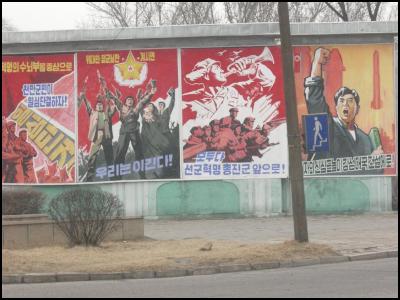
After months of organisation and belated email exchanges between a North Korean tour company, the New Zealand DPRK friendship society and ourselves (group of three Auckland University Arts students), what begun as a faint idea sometime last year in the Quad was about to happen.
We were accepted and furthermore invited to the Democratic People’s Republic of Korea (DPRK) or more commonly know round these parts as North Korea. Beginning with a 2 ½ hour flight from Beijing on board a 1960s Soviet jet, our six day glimpse into the ‘hermit state’ took us around Pyongyang, to the DPRK founder Kim Il Sung’s tomb, the Demilitarization Zone (DMZ- the border area with the South), to the ancient capital of Korea; the city of Kaesong.

We also partook in some good old fashioned labour on the affectionately named ‘New Zealand Friendship Farm’, talked politics with some ‘Pyongyang officials’ and some highly intelligent students as well as sharing many good memories and conversations with young soldiers and our tour guides. The trip wound up with a 24 hour train ride from Pyongyang to Beijing on board yet another marvel of old Soviet design which dominates the infrastructure in the DPR of Korea.
Upon arriving at Pyongyang airport you realise exactly where you are. The proud, smiling face of the former ‘Great Leader’ Kim Il Sung’s portrait hangs above the only, relatively small and calm terminal. On each side of the airport runway, peasant farmers tend to dry fields which have only recently defrosted after a long, freezing winter. It is the very beginning of spring in North Korea and every last piece of cultivable land is being prepared for rice, potato and grain planting over the next months.
Our
bags are checked, passports looked at with the stern faces
of any immigration or customs official, we are asked if we
are carrying international cell phones- instruments which
are outlawed- this we knew and thus did not attempt to carry
any. As we stepped out into the cold, fresh air our guides
welcome us with a handshake, Rimoni and I remained quiet
while Vadim enthusiastically broke the ice with our new
friends for the next six days.
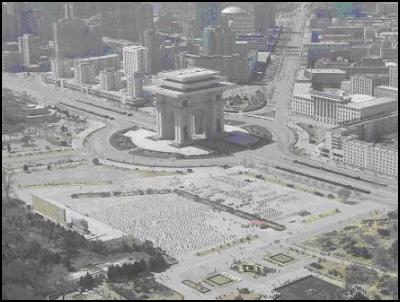
Baat, a former military para-trooper who spent 22 years of his life serving in the ‘People’s Army’ and Kim a young, fresh faced and chirpy but quiet ex Mig fighter pilot (or so we assumed by his exceptional and often freakishly fast driving) were our guides, our; comrades if you will, for our time in North Korea.
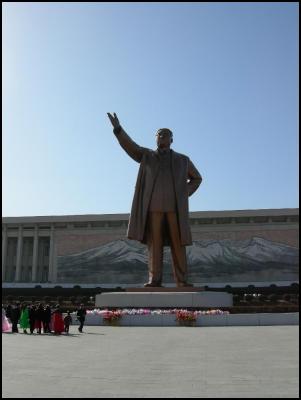
What soon becomes obvious when driving through the almost empty streets of Pyongyang is first; how few cars there are, and second; the immense pride the country bestows on its revolutionary history. Monuments that would literally dwarf anything we have ever seen (even in books), speckle the view of the city, monuments to the heroic struggles of the past and victories against ‘foreign imperialists’. A huge ‘Arch of triumph’ (standing taller than its French counterpart. How much taller? We were never told) donned by bronze statues of flag waving revolutionaries commands rising before us as we make our way to our hotel. Huge posters of people marching forward, workers, children and Kim Il Sung colourfully dominate the otherwise bland and grey roadsides of the capital city.
Wishing to make a desirable impression on our guests and being aware of the fact that when visiting important cultural sites in North Korea (as well as any country) one is to show a great deal of respect- we were already wearing suits when we visited a 30 metre, pristinely polished bronze statue of Kim Il Sung.
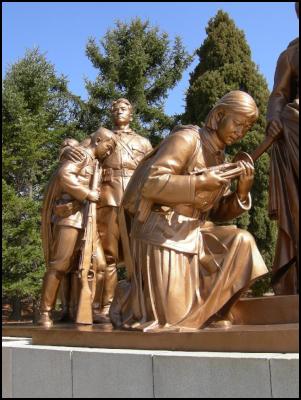
memorial
At the foot of the statue we lay flowers handed to us by Baat and Kim. Flanked on either side of this impressive statue are 50 to 70 metre long bronze panoramic statues of revolutionaries, war heroes, children and mothers striving forward toward a socialist ideal with rifles, pitch forks, hammers and sickles.
Rising above the confused but intricately designed statue of Koreans marching forward- a strong hand holds a torch; an icon of North Korea, the ‘Juche’ torch. ‘Juche’ being a hybrid of ideas which Kim Il Sung developed as he lead the Korean fight against the Japanese occupation- its guiding principle is self sufficiency and the control of one’s own destiny- as well as maintaining classic Marxist principles.
Altogether, this amazing monument of solid and polished bronze and marble is perched atop a hill overlooking a rather colourless and in patches dilapidated Pyongyang. Dotted around the front of the monument site (about the size of two rugby fields) are groups of Korean wedding processions paying homage to the ‘Dear Leader’ on their special day; this was the first time we observed the impact the leader who has been dead since 1994 still has on ‘his’ people. On a Sunday, when people are celebrating their wedding day, this is the most popular place in Pyongyang for them to visit- even in the personal life of Koreans, the ‘Dear Leader’ plays an important role. The reverence the people of North Korea have for the ‘Dear Leader’ was further and poignantly demonstrated.
On day two we are instructed to dress well for a visit to the ‘Kim Il Sung monument palace.’ We don our suits once again and after a short drive though a series of ordinary streets arrive at the beginning of boulevards that were surprisingly well maintained compared to any roads we had seen so far. The manicured streets surrounded by rows of trees with an almost Parisian style to them indicate that we were in the vicinity of the monument.
We soon arrived at the entrance of a huge open square, possibly the size of five or six football fields. Once out of the van we made our way to a marble walkway which leads to a long runway with windows on both sides. Ahead of us was a horizontal escalator about a kilometre long which ran alongside a huge marble palace resembling something perhaps five times the size of Auckland museum. To the left of us was a 20-30 metre-wide moat which surrounded the whole complex; we judged it to be anywhere between 15-20 acres.
Facing us from the middle of the palace was yet another smiling face of the ‘Great Leader’ Kim Il Sung; atop was a fluttering North Korean flag. We entered a long corridor and passed through a metal detector which seemed strange to us at first; we emptied our wallets of everything, including wallets, keys and cameras. ‘This place is very sacred; nothing ‘impure’ must enter,’ being explained to us in a whisper by our young guide- Kim. Next thing we know, our group as well as two Canadian tourists are instructed to walk over a grilled floor contraption with bristles to clean the soles of our shoes, then onto sponges to rinse the soles so as not to bring any dirt into the palace of the ‘Great Leader’. All this happens while being completely surrounded by polished marble you could almost see your reflection in; everything in this memorial is made of polished marble. We continue on a horizontal escalator for over a kilometre, turn though a corridor and up an escalator until we reach a tunnel like doorway with small fans on either side to brush off any dust (we assumed) that our suits may carry.
By now none of us were saying much as our walk seemed to be building up, we were confused and excited as to what waited for us in the next room. Next: A lift ride up a floor, no more windows, and there at the end of what was yet another huge (perhaps 70 meter long) hallway with polished pillars reaching to a 20 metre high ceiling was a perfectly, carved and pristinely white statue of Kim Il Sung. With soft, surreal classical music playing delicately in the background the, guests to the palace (we among a small number) were quietly aligned into rows of four, each row having to walk from the entrance of the hall to the statue at precise intervals.
We bowed slowly and solemnly and there is really nothing to look at while you walk through the hall but this amazing statue which mimics ivory in its colour. The only noise in the room is the music and the sound of foot steps echoing off the marble walls. To the right of the statue, we entered a smaller room, with black polished marble walls and floor; in the middle lay a preserved Kim Il Sung with a North Korean flag draped over his waist. Mao, Ho Chi Minh and Lenin were pickled in liquid, but as the Korean Leader only passed in 1994, he was preserved in a sealed case with the use of gases and as a result looks almost alive.
We bowed to every side of his body as instructed to. I’m not too sure about my fellow travellers at this point but my heart was pounding as I witnessed one Korean visitor begin to shed tears. On all corners of the room as well as right through the palace stand stone faced guards with chromed silver Ak-47s which are covered with delicate designs. I would have liked to see them closer but I wasn’t keen to stare, or dare ask for anything out of the ordinary in place like this.
Visiting the resting place of North Korea’s founding father was one of the most humbling experiences of my life and it laid the foundations in our minds into understanding how important ‘The Great Leader’ and his ‘everlasting legacy’ is to the North Korean people. The word ‘legacy’ is emphasised because dotted around the city and countryside amongst many other repetitive slogans promoting national unity proclaim that ‘Kim Il Sung will live forever’ in the hearts and minds of the Korean people.
We visit a ‘war hero’ memorial of a few hundred polished bronze torsos of men and women, their faces proudly and sternly overlooking a not too distant Pyongyang. With these torsos come tales of heroism and sacrifice against a brutal Japanese occupation that never quite extinguished a fiery Korean campaign of rebellion. As well as Korean freedom fighters against the Japanese, were fighters and veterans of the Korean War, which exploded little more than five years after the country was divided between North and South in 1950 and spanned three extremely bloody years.
The death toll of the Korean War for both combatants and civilians remains contested and debated by parties involved as well as academics and researchers. It is however evident that Korea was left devastated under heavy bombing form both sides, what remained after the war amounted to little more than rubble, a political deadlock and a refreshed sense of animosity towards what North Korean’s saw as ‘foreign imperialists’- namely the United States. The history of regular occupation by the Japanese which spans over three centuries and the United States-led war lends to the mindset of Korea as a nation and people that has had to deal with historically frequent aggression and invasion.
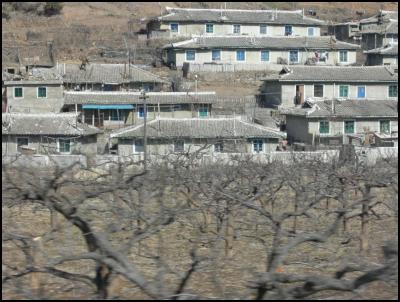
The next stage of our snapshot of North Korea entered it’s most anticipated stage- the visiting of the Demilitarisation Zone (DMZ) where the borders of the North and South meet for a few hundred meters and soldiers from both sides stare at each other with all the imagined intensity from when the Korean War was uneasily ended. Upon arriving at this zone we visit the signing house of the armistice between US led United Nations forces and the DPRK forces, it was there that the agreement (which was only supposed to be temporary solution) cemented the Korean peninsula into the situation that continues to this day.
Escorted by three rather imposing but friendly soldiers, our van was driven along a one mile road to the ‘meeting houses’ and viewing buildings which tower above the short area where visitors from both sides may cross the border very briefly. We were to momentarily traipse over the border whilst inside one of the North Korean controlled meeting houses. All the stereotypes of an extremely tense and unnerving experience which echo from visits to this place from the South proved inconsistent with what we saw.
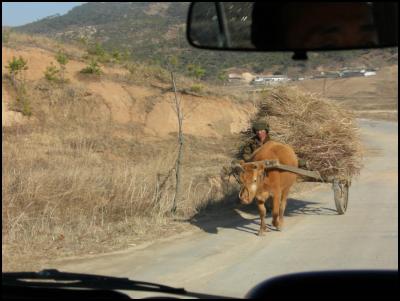
Apart
from a display of the North and South eyeballing each other,
it was Baat, our guide who summed up his feelings toward the
DMZ, the border and the stand-off on either side of it:
“This is our national tragedy, many tourists say… it’s an
exciting, or interesting place… But for us, this is a symbol
of our national tragedy- the division of our people.”
We spent six life changing days in the Democratic People’s Republic of Korea, three Politics students from Auckland, New Zealand in the DPRK. We visited a cooperative farm, exchanged niceties with the Korean end of the New Zealand DPRK friendship society and engaged in some interesting, although politely diplomatic discussions with its members, as well as soldiers and our guides Kim and Baat. From our brief look we witnessed a different way of life from what we had ever seen before.
The city of Pyongyang, with its
Soviet styled bus/trams and metro system: to the stark
contrast between the monuments of brass grandeur and the
grey and colourless urban landscapes, it was our home for
most of our time there. Pyongyang maintains approximately 2
-3 million people of a national population of 22 million.
For the majority of North Korean people, life on cooperative
farms with few amenities, battling with freezing winters in
communities of a few thousand is the norm.
I During out
time in the cities of Pyongyang and Kaesong, the power would
regularly turn off- everyone, logically reverts to candles.
What again was poignant was the fact the lights to the
monuments never went out.
The DPRK is a land of the past. The culture, as with most of the worlds, is based on the glorification of the past heroic actions of its people and its leaders. The city of Pyongyang was a well thought out plan; it has a metro system and an exceptionally designed road system- qualities Auckland City Council could learn a lot from. From Pyongyang to the cooperative farms across the countryside, the place was a meticulously constructed plan for a Socialist state.
For many reasons, these plans and preparations for a perfect model from which the world was to learn just didn’t happen. The world has changed around the DPRK- it is more isolated than ever before in terms of its people, as well as its geo- political role in North East Asia and the World. China is trudging along its an industrious path to become the worlds next super power; Russia is finally recovering from the 1990s and growing as an independent economic power; the allies the DPRK has traditionally had are slowly distancing themselves in many ways.
Having been devastated, many times over by foreign
powers and guided by a philosophy teaching national self
sufficiency it is not hard to understand why they view a
fast paced, US led west with suspicion. The people we met
were proud and staunchly patriotic, but also deeply
interested in the ‘outside world’ as well as our personal
world views. What we witnessed during our short stay were
not an ignorant or ‘backward’ people as stereotypes often
suggest, but warm, gracious and surprisingly open people.
Without delving into ‘big politics’- I’ll leave that to my
politics essays- what we saw in terms of the everyday life
of many North Koreans were a people trying to survive,
thrive and succeed in life just like anywhere
else.
-
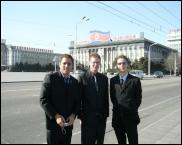 Vadim Piatov, Nick Healy and Rimoni Leota
spent six days in North Korea during May of this year. All
three are Politics students from Auckland. Pictured are
Rimoni, Nick and Vadim in Pyongyang’s central square; the
site of the much publicised military parades which flash
upon television screens whenever North Korea in mentioned in
mass media.
Vadim Piatov, Nick Healy and Rimoni Leota
spent six days in North Korea during May of this year. All
three are Politics students from Auckland. Pictured are
Rimoni, Nick and Vadim in Pyongyang’s central square; the
site of the much publicised military parades which flash
upon television screens whenever North Korea in mentioned in
mass media.
ENDS


 Binoy Kampmark: The Australian Defence Formula, Spend! Spend! Spend!
Binoy Kampmark: The Australian Defence Formula, Spend! Spend! Spend! Ian Powell: New Hospital Building Trumps ‘Yes Minister’ Hospital Without Patients
Ian Powell: New Hospital Building Trumps ‘Yes Minister’ Hospital Without Patients Mike Treen: Prices Are Still Rising - It's A Cost Of Living Crisis
Mike Treen: Prices Are Still Rising - It's A Cost Of Living Crisis Gordon Campbell: On When Racism Comes Disguised As Anti-racism
Gordon Campbell: On When Racism Comes Disguised As Anti-racism Peter Dunne: Newshub And TVNZ Tip Of Media Iceberg
Peter Dunne: Newshub And TVNZ Tip Of Media Iceberg Harry Finch: Austerity – For And Against
Harry Finch: Austerity – For And Against